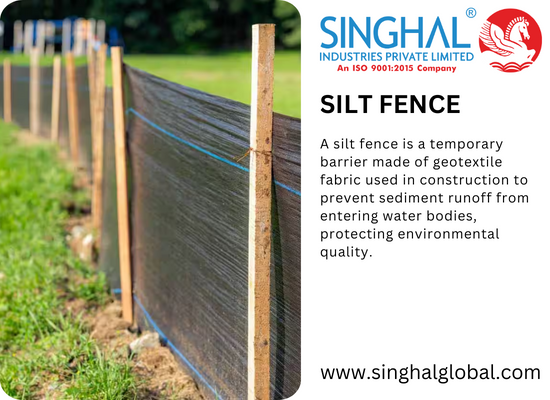Understanding Silt Fence: Effective Erosion Control for Construction Sites
- Nurul Amin
- Jun 20, 2024
- 3 min read
Construction projects, large or small, often come with environmental responsibilities. Among these is the need to prevent soil erosion and manage sediment runoff effectively. One crucial tool in the arsenal of erosion control measures is the Silt Fence Manufacturer. This article dives deep into what silt fences are, how they work, their installation process, and addresses frequently asked questions to provide a comprehensive understanding of their role in construction site management.

What is a Silt Fence?
A silt fence is a temporary sediment control device used on construction sites to prevent soil erosion and control sediment runoff. It typically consists of geotextile fabric stretched between wooden or metal posts, forming a barrier that intercepts sediment-laden runoff water. The fabric allows water to pass through while trapping sediment, hence reducing the impact of construction activities on nearby water bodies and ecosystems.
How Does a Silt Fence Work?
The functioning of a Silt Fence Manufacturers revolves around its design and placement. Key components include:
Geotextile Fabric: The fabric used in silt fences is specially designed to allow water to flow through while filtering out sediment particles. This prevents sediment from being carried away by runoff water.
Supporting Posts: Wooden or metal posts are driven into the ground at intervals, holding the fabric in place and providing stability against water pressure.
Installation Depth: The fabric is buried to a recommended depth below the ground to enhance its effectiveness in trapping sediment.
Installation Process
Installing a Silt Fence Price involves several steps to ensure its efficacy:
Site Assessment: Evaluate the terrain and identify the areas prone to runoff. Determine the appropriate locations for placing silt fences based on the slope and proximity to water bodies.
Material Selection: Choose geotextile fabric suitable for the site conditions, ensuring it meets regulatory standards for filtration and durability.
Post Placement: Install supporting posts securely into the ground at regular intervals, ensuring they are adequately spaced to support the fabric and withstand water pressure.
Fabric Installation: Unroll the geotextile fabric along the line of posts, burying the bottom edge to the recommended depth and securing it tightly to the posts.
Maintenance: Regularly inspect and maintain the silt fence to ensure it remains intact and functional throughout the construction phase.
Conclusion
In conclusion, silt fences play a crucial role in mitigating the environmental impact of construction activities by controlling sediment runoff and preventing soil erosion. Understanding their design, installation process, and maintenance requirements is essential for ensuring their effectiveness on construction sites. By adhering to best practices and regulatory guidelines, construction professionals can integrate silt fences seamlessly into their erosion control strategies, promoting sustainable construction practices and environmental stewardship.
Frequently Asked Questions (FAQs)
Q1: Why is sediment control important on construction sites?
A1: Sediment control prevents soil erosion, maintains water quality in nearby water bodies, and ensures compliance with environmental regulations.
Q2: How effective are silt fences in controlling sediment?
A2: When properly installed and maintained, silt fences can significantly reduce sediment runoff by trapping sediment-laden water and allowing clean water to pass through.
Q3: What are the advantages of using silt fences over other erosion control methods?
A3: Silt fences are cost-effective, easy to install, and can be customized to suit different site conditions. They also require minimal maintenance compared to other erosion control measures.
Q4: Can silt fences be reused?
A4: While the fabric of silt fences may not be reusable due to contamination with sediment, the supporting posts can often be reused for multiple projects with proper cleaning and maintenance.
Q5: Are there regulations governing the use of silt fences?
A5: Yes, local and federal regulations may govern the installation and use of silt fences, including specifications for materials, installation depth, and maintenance requirements.



Comments